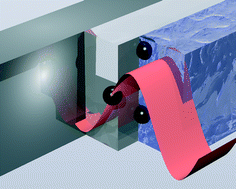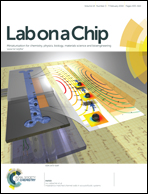Impedance matched channel walls in acoustofluidic systems†
Abstract
Acoustophoresis in bulk acoustic wave (BAW) devices typically operates with an ultrasonic standing wave in a microfluidic channel between two opposing silicon walls, which act as both the acoustic and the fluidic boundary. In this paper, we describe BAW devices with an additional material layer of polydimethylsiloxane (PDMS). This PDMS wall is introduced to decouple the acoustic boundary (silicon wall) from the fluidic boundary (PDMS wall) by acoustic impedance matching. The acoustic field and the resulting particle manipulation are thereby less restricted than in conventional BAW devices. In the presented devices, particle accumulation lines can be placed arbitrarily within the fluidic domain, which strongly increases the possibility of acoustophoresis. The paper covers experimental results, an analytical model in good agreement and microfabrication techniques for PDMS enclosed in a microchannel. An application example for microparticle concentration is demonstrated. The presented approach offers further potential for biotechnological applications such as particle separation, enhanced particle sensors and cell handling.


 Please wait while we load your content...
Please wait while we load your content...